|
An Interview with Mr Lee Bock Guan, President of the Singapore Buddhist Lodge
 The SBL donated 600,000 yuan to rebuild Jiujiang City, Jiangxi, China, after an earthquake in 2005.
The SBL donated 600,000 yuan to rebuild Jiujiang City, Jiangxi, China, after an earthquake in 2005.
In December last year, Mr Lee Bock Guan, President of the Singapore Buddhist Lodge (SBL), was hospitalised after the onset of a stroke. This, however, did not stop Mr Lee from fulfilling his official duties as Lodge President during the difficult period of his recovery. Admirably, his main concern at the time was that his sickness would “delay much needed help to the needy”. For 40 years, this man has called the SBL his home, and has contributed tirelessly to the welfare of the Lodge and to society at large. He is also the man behind the initiation of the SBL Education Foundation in 1979, an educational funding programme that awards bursaries to needy students and families. Currently, nearly $1 million is given out annually. The total amount distributed by the Foundation from 1979 to 2012 comes to $14,269,900. This money went out to 30,268 beneficiaries.
In seeking to understand how a religious organisation like SBL can centre its charity operations on education, and how it reaches out to other religious bodies like the Muslim, Hindu and Taoist organisations to collaborate on educational funding projects, EduNation spoke to Mr Lee about his views on how community partners can come together and be a catalyst for the development of education in Singapore.
Any Generation That Misses Out On Education Will Naturally Suffer From Poverty
The origin of the SBL Education Foundation can be traced back to the 1970s, when Mr Lee was a young man in his twenties. At that time, Mr Lee, an active participant of SBL activities, was tasked to survey the circumstances of the financially needy. He realised that the fundamental problem plaguing these poverty-stricken families was the lack of formal education. Families that had several generations missing out on formal education invariably found themselves stuck in a vicious cycle of poverty with no means of improvement.
 These real life case studies made him acutely conscious of the fact that education has great bearing on a person’s fate and future, and therefore any project that seeks to elevate social circumstances on a global scale must first start with elevating standards of education. Mr Lee said, “Generally, an educated person will not fare too badly in terms of contentment. Any development seeking to elevate poverty across national, racial and domestic levels must therefore begin with a common starting point — the elevation of educational standards. If a country’s educational standards are well established, it will thrive and prosper, and its citizens will not live in poverty. I have witnessed the consequences of many countries not having developed their educational infrastructure. And the uneducated masses that result are easily incited and manipulated to protest and strike. A two-dollar note and a packet of rice can easily send a population into disarray, and a country into chaos.” These real life case studies made him acutely conscious of the fact that education has great bearing on a person’s fate and future, and therefore any project that seeks to elevate social circumstances on a global scale must first start with elevating standards of education. Mr Lee said, “Generally, an educated person will not fare too badly in terms of contentment. Any development seeking to elevate poverty across national, racial and domestic levels must therefore begin with a common starting point — the elevation of educational standards. If a country’s educational standards are well established, it will thrive and prosper, and its citizens will not live in poverty. I have witnessed the consequences of many countries not having developed their educational infrastructure. And the uneducated masses that result are easily incited and manipulated to protest and strike. A two-dollar note and a packet of rice can easily send a population into disarray, and a country into chaos.”
It was this that drove him to convince Mr Linn In Hua, then-president of the SBL, to begin the funding project that is SBL’s Education Foundation.
Revenue from the Memorial Hall Helps to Spread Good Deeds
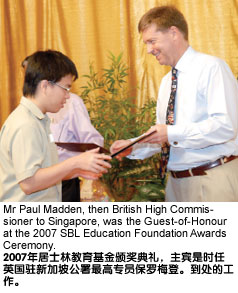 In the initial stages of the project, the Foundation’s fundraising fell short of its $500,000 target, raising only $35,000. The funds were sufficient only for about a hundred beneficiaries, but that was more than enough to raise Mr Lee’s spirits. At the time, money was not given to students beyond Secondary 4 but in the years that followed, Singapore would experience economic development and its associated increase in demands for formal qualifications. Mr Lee therefore decided to assist older students. Consequently, the bursaries are now distributed across polytechnic and university students as well. Mr Lee resolutely believes that “Buddhism is founded upon compassion, and that charitable acts are mandatory, and the focus of these should be the elevation of education”. To this end, he spares no effort in maximising the Foundation’s means of accumulating funds for the benefit of the needy. In the initial stages of the project, the Foundation’s fundraising fell short of its $500,000 target, raising only $35,000. The funds were sufficient only for about a hundred beneficiaries, but that was more than enough to raise Mr Lee’s spirits. At the time, money was not given to students beyond Secondary 4 but in the years that followed, Singapore would experience economic development and its associated increase in demands for formal qualifications. Mr Lee therefore decided to assist older students. Consequently, the bursaries are now distributed across polytechnic and university students as well. Mr Lee resolutely believes that “Buddhism is founded upon compassion, and that charitable acts are mandatory, and the focus of these should be the elevation of education”. To this end, he spares no effort in maximising the Foundation’s means of accumulating funds for the benefit of the needy.
The SBL has a memorial hall on its third floor. This is where devotees can place their ancestral tablets at a cost of $8,100 a unit. Ever determined to increase the volume of funds for the needy, Mr Lee once again convinced then-president Mr Linn In Hua to channel all the revenue from the memorial hall into the Education Foundation. The annual revenue received by the memorial hall amounts to approximately $1 million and channelling these funds into the Foundation meant that the SBL could distribute more than $900,000 in bursaries every year.
With its tax-exempt status, all incoming funds can be fully channelled into helping the needy and the SBL absorbs all administrative costs of operation. Mr Lee said, “Each and every penny from this fund is used for bursary distribution — the SBL administrative staff members are contributing on a voluntary basis.”
Bursary Distribution is Based on Need, and Transcends Race and Religion
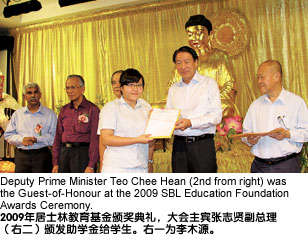 Race and religion have no bearing on the SBL’s judgement and decisions regarding bursary distribution. The only deciding factors are necessity and family circumstances. A significant portion of the funds is awarded to non-Chinese and non-Buddhist students. The bursary awarding ceremony is sensitive to other cultures, void of religious elements and does not deliver any religious teaching. Beneficiaries do not pay salutations to figures of Buddhism. Race and religion have no bearing on the SBL’s judgement and decisions regarding bursary distribution. The only deciding factors are necessity and family circumstances. A significant portion of the funds is awarded to non-Chinese and non-Buddhist students. The bursary awarding ceremony is sensitive to other cultures, void of religious elements and does not deliver any religious teaching. Beneficiaries do not pay salutations to figures of Buddhism.
In 2000, the SBL invited the Jamiyah Singapore and the Hindu Endowments Board to form a joint foundation. The Taoist Federation (Singapore) soon followed. This is a real life example of racial, language and religious boundaries being overcome to usher in progress and inclusivity for the good of all needy students.
Things were not necessarily easy for Mr Lee, whose intentions were naturally questioned when he first initiated the collaboration. “They [the other religious bodies] questioned my motives at the beginning, and suspected my work as having religious inflections,” said Mr Lee. “But we remain insistent on not having such inflections in our charity work, and after ten years of collaboration, we have reached an understanding that the SBL’s work stems from nothing other than pure intentions of helping the needy.”
Mr Lee is adamant that charity must be driven by sincerity and purity. “This is analogous to the duty of doctors,” he said. “It is not okay for a Buddhist doctor to forsake patients who don’t believe in Buddha. Similarly, we do not choose to help the needy based on their beliefs. We welcome any religious organisations to collaborate with us. Even the vegetarian food we provide here is safe for consumption by devotees of other religions. We welcome them. These dishes are definitely not inflected with religious significance by any rites. We would never do that.”
Mr Lee is of the firm belief that society will always stand to gain from religious bodies reaching out to help each other. He said, “Individually, we are like lamps with limited reach. If the lamps come together they can shine brighter, and reach out further. I believe our different lights can blend harmoniously.”
A significant portion of the Education Foundation’s funds goes to aiding the needy from the Institutes of Technical Education (ITE). The demography of these beneficiaries is largely made up of non-Chinese students. Many of these youngsters have a weak academic foundation as they missed out on kindergarten. This has further hindered them from doing well when they started primary school. Mr Lee is happy to note the betterment of the current situation, and that many Malay parents now see their children’s education as a priority.
Every year, the SBL Education Foundation publicises its bursaries in the press. They fall into two categories: the primary/secondary and the tertiary, which includes ITE, junior college, polytechnic and university students. Families receiving assistance must have a combined monthly income below $750, and each family is entitled to a maximum of two beneficiaries.
“Applicants need to request for the official application forms from the list of beneficiary schools and organisations. If the application is approved, the SBL will transfer funds to the school twice a year. We emphasise that the funds are not interchangeable for use between different needy students. The money can be channelled only towards helping one specific student. It can be used to pay for uniforms, school fees and other miscellaneous academic spending. If the student withdraws from class, the school needs to return any unspent amount. We never transfer funds directly to the parents — this is to guard against any propensity for misuse.”
If the needy student’s school does not appear on the provided list of beneficiary organisations, he or she is still welcome to meet Mr Lee personally at the SBL. Mr Lee said, “If we find these applicants to be truly in need after a home visit and survey, we have another charity group on the side that can provide funds to pay for basic provisions as well as academic spending.”
A Home Visit Veteran Shares His Experiences
Mr Lee has a considerable amount of home visit experiences under his belt. A short amount of time within a home can tell him what he needs to know to judge whether a family requires financial assistance.
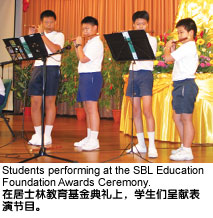 “If we feel there is something off with the application form, we will normally make calls first to get a better understanding of the family’s residence type, and whether they have a maid,” he said. “If I make a house visit in person, I will normally enter the kitchen first and maybe think, ‘This fridge is not all that bad.’ The quality of groceries inside the refrigerator is a good tell-tale sign whether the family is genuinely in need of assistance. Sometimes, the strong smell of essential balms and medicated oil hits you the moment you enter a unit. This usually indicates the presence of sick family members. If the living room is in tatters, and the family members are sickly, the family is naturally not doing financially well.” If the SBL suspects applicants of intentionally withholding information or attempting to deceive, then the surveyors will interview their neighbours to discern a clearer picture. “If we feel there is something off with the application form, we will normally make calls first to get a better understanding of the family’s residence type, and whether they have a maid,” he said. “If I make a house visit in person, I will normally enter the kitchen first and maybe think, ‘This fridge is not all that bad.’ The quality of groceries inside the refrigerator is a good tell-tale sign whether the family is genuinely in need of assistance. Sometimes, the strong smell of essential balms and medicated oil hits you the moment you enter a unit. This usually indicates the presence of sick family members. If the living room is in tatters, and the family members are sickly, the family is naturally not doing financially well.” If the SBL suspects applicants of intentionally withholding information or attempting to deceive, then the surveyors will interview their neighbours to discern a clearer picture.
The home visits of Malay and Indian families are conducted with the assistance of Jamiyah Singapore and the Hindu Endowments Board. Mr Lee feels this is “more appropriate”.
Giving Without Expecting a Return
The SBL awards bursaries without any expectations of return. Mr Lee said, “I will tell the children, ‘We do not want any returns for the bursaries we give you. If you wish to make any return contributions, make them to your family, your racial community, and your country.’ We give university students volunteer work application forms to encourage them to give back to the community. We encourage them to volunteer for their own religious organisations as well. They do not necessarily have to volunteer for the SBL.”
Although there is no expectation of return or rewards, the SBL still has a considerable number of beneficiaries who can never forget their roots and go on to show their appreciation after graduation. Prominent examples include an Indian student who later became a lawyer, and another Indonesian beneficiary who went back to his home country. Both regularly contribute thousands of dollars to the SBL every few months. There are also beneficiaries who invite the SBL to their weddings.
Mr Lee said, “I meet SBL beneficiaries wherever I go — some of them go on to become pilots, lawyers and doctors. It is a joy to see them fulfil their potential. Some show their appreciation to me with food, and there was this occasion where I met a cab driver and ex-beneficiary who did not want to charge me for my ride — I insisted on paying, of course. Even when I was recuperating in the hospital, I had the joyful experience of having many doctors who were ex-beneficiaries show their concern for me in person.”
Thus, one can observe that there is no lack of gratitude. As the Chinese saying goes, “give the person who gives you a drop of water a fountain of gratitude” — the SBL now has around a thousand volunteers. Polytechnic students and bank employees are regular participants as well. Mr Lee said, “50 to 60 Temasek Polytechnic students often come here to cook for us, and we provide the opportunity for them to practice. Other schools also tell us that they are more than willing to help should we ever be in need. This is why all our activities and performances are covered by school emcees and performers. One year, students from LASALLE College of the Arts came to perform contemporary dance.”
A Bothersome Principal is a Good Principal
The SBL Foundation approves more than 90 per cent of its annual applications. On average, every beneficiary school receives ten bursary awards. There are some principals who take the initiative to earnestly request for more — and the SBL will make exceptions for these. Mr Lee said, “Normally, our policy dictates that applicants need to use the official application forms. However, many schools have an overwhelming number of applicants, and the principals end up having to photocopy the forms for them. Many of these principals actually turn up in person to make requests, and send their teachers to follow up on them. We approve almost all of these.”
 There are some principals who give SBL “a difficult time”, as Mr Lee jokingly put it. “These bothersome principals are all good principals. Only good ones would actively seek us out. The ex-principal of Crescent Girls’ School is a good example — after we gave the School ten official application forms, she came and requested more on a daily basis until she got 30 of them. The ex-principal of River Valley High School, Mdm Leong Fan Chin, often used to visit us to make requests for assistance with the needy in her School.” There are some principals who give SBL “a difficult time”, as Mr Lee jokingly put it. “These bothersome principals are all good principals. Only good ones would actively seek us out. The ex-principal of Crescent Girls’ School is a good example — after we gave the School ten official application forms, she came and requested more on a daily basis until she got 30 of them. The ex-principal of River Valley High School, Mdm Leong Fan Chin, often used to visit us to make requests for assistance with the needy in her School.”
The most unforgettable principal in Mr Lee’s experience is the ex-principal of Bukit View Secondary School, Mr Ow Chiong Hoo. Mr Lee said, “Other than turning up in person to request bursary application forms from me, this principal also delivered provisions like rice to his students. His tires often threatened to burst from the heavy load he carried in his car — now that’s an example of a good principal.”
Mr Lee also made special mention of NorthLight School, which specialises in taking in and assisting students who have difficulty in handling the mainstream curriculum and passing the Primary School Leaving Examination (PSLE). Mr Lee said, “The past and current principals of NorthLight School, Mrs Chua-Lim Yen Ching and Mr Martin Tan Siew Kin, are both good principals who have not only come to us but have also distributed our provisions and fruits to their students. Many of the students from NorthLight come from needy and single parent families. I particularly admire how the school has a 24-hour open gate policy to allow students to take refuge during the night if they need to — some of these students do come from more complicated backgrounds. We too, will try our best to help this kind of school.” Mr Lee often takes the initiative to write letters to the Ministry of Education (MOE) to commend the diligence and compassion of these excellent principals.
The SBL Also Assists with Overseas Immersion Expenses, Exam Fee Payments and Computer Purchases
Among the beneficiary schools, there are some that appear to be “rich”. Do these schools with resources also require financial assistance? Mr Lee explained, “These schools still have poor students; even rich people have poor relatives. Sometimes, when students want to participate in overseas immersion programmes, but cannot afford to do so, their schools will take the initiative to request for our assistance. Hwa Chong, for example, has come to us before to help some needy students attend an overseas immersion course in the United States.” Mr Lee said that the SBL feels a strong obligation to assist students with the desire to participate in these immersion programmes, “We must let them go. Students with good family circumstances will not have difficulty going overseas — eight hundred to a thousand dollars is not a problem to their parents. But a needy student will not find such opportunities easily — that is why we will financially support them.”
The SBL funds also cover the students’ examination fees. “There was a year where Nan Chiau High School came to me requesting for assistance with five students’ examination fee payments. These students did very well for their examinations in the end. Families with a number of children, especially children at the primary school and secondary school leaving levels, will often incur very high expenses. Entering secondary or pre-university education will incur associated expenses such as buying uniforms, bags and texts. These expenses can amount to a thousand dollars. How can a poor family withstand such a burden?”
In recent years, many schools have adopted the approach of educating students through the use of tablet computers. Naturally, the SBL has received a substantial volume of requests for assistance in purchasing such devices for students. “Some schools have come to us hoping that we can purchase computers for the entire student body. How is that possible? I do feel they can try seeking assistance from MOE. MOE has a very substantial budget as well. It is impossible for us to help an entire school body. Besides, if we do it for one, another will immediately follow.”
However, as far as computer purchases go, the SBL does provide assistance on a case-by-case basis. For example, it assisted a young man from China who was studying at Nanyang Technological University but who could not afford his own computer. This student had to wait for his schoolmate to go to bed before borrowing his computer, which naturally had consequences for his biological clock. Mr Lee recalled, “When he finally laid his hands on a computer that he could call his own, he was so affected that he burst into tears holding it. He even slept with it in his arms.”
Introducing the Endeavour Award as a Form of Motivation
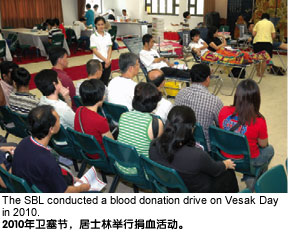 In trying to motivate beneficiaries in their studies, the SBL has introduced three Endeavour Award cash prizes in 2010. These awards are also designed to encourage students with satisfactory results to strive further for academic excellence. The cash prize is handed directly to the students themselves, and they are allowed to reward themselves with this money. In trying to motivate beneficiaries in their studies, the SBL has introduced three Endeavour Award cash prizes in 2010. These awards are also designed to encourage students with satisfactory results to strive further for academic excellence. The cash prize is handed directly to the students themselves, and they are allowed to reward themselves with this money.
Mr Lee said, “I recall a little girl who was given the prize money. After getting the award she wanted to give it up. She said, ‘Even though I am poor, I have a Malay schoolmate who is poorer than me. This should go to him.’ Thus, we ended up transferring the prize money to this schoolmate, but at the same time we also awarded another special prize to this girl. We saw in her a community spirit that transcends race and religion, something that left us very touched.”
Building Schools in the Remote Areas of China
The SBL’s light seeks to be far-reaching. Through the Project Hope channel, its charity work has taken root in certain remote areas of China like Yunnan, Guizhou and Gansu, and has given rise to the construction of around a hundred schools. “In the past, the construction of a school building only required seventy to eighty thousand dollars. Now, with demands for computers and central heating, we need to set aside $200,000 for each school. And because each school building needs to last 70 years, we need, before construction starts, to secure reassurance from the government on transport, water and electrical infrastructures. Their education ministry also has to guarantee a continuing supply of teachers, and a restriction on the use that the building can be put to.”
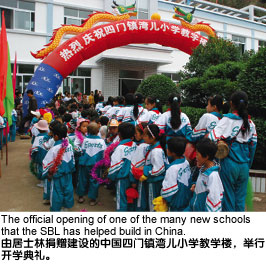 Other than the construction of school buildings in remote areas, the SBL also funds the overseas studies of outstanding students from these regions. A female student of an ethnic minority numbering only 30,000 managed to seek out the SBL through the channel of The Buddhist Association of Yunnan. As a result, she managed to get her PhD, and return to Shanghai to work in the finance sector. She is the sole overseas graduate from her ethnic group. Other than the construction of school buildings in remote areas, the SBL also funds the overseas studies of outstanding students from these regions. A female student of an ethnic minority numbering only 30,000 managed to seek out the SBL through the channel of The Buddhist Association of Yunnan. As a result, she managed to get her PhD, and return to Shanghai to work in the finance sector. She is the sole overseas graduate from her ethnic group.
Additionally, the SBL has financially assisted a hundred or so foreign students to pursue their education in Singapore. Mr Lee feels that encouraging outstanding talents to come to Singapore is the right thing to do. Whether these individuals stay or return to their home countries, they will still play a part in contributing to Singapore’s development. He describes this as “an investment for establishing a firm foundation for our country’s future”.
Completion of the Singapore Buddhist Lodge Cultural Activities Centre in 2017
The SBL is planning the construction of a Cultural Activities Centre beside its Grand Hall. The building will be six storeys tall with three levels of underground parking space. The building’s estimated completion date is 2017 and it is estimated to cost $50 million. Mr Lee hopes that the new building, with 70,000 square feet of usable space, will provide room for young people to expand the scope of their activities. In some earnest he said, “I came into the SBL in 1970. At that time the then-new buildings became my responsibility. It has been a long run of 40 years, and I have grown old with them. Before my own term is up, I must see this new construction project through, and hand it over to the next generation. If I don’t see it through within my term of service, I don’t know when it can happen. Fortunately, I have broad connections, and this makes fundraising an easier task.”
When Mr Lee first joined the SBL, he made a vow “to always do good for mankind, and to never falter spiritually”. In his 40 years of service, he has been loyal to his duties, and turned his ideals into tangible contributions. From the bursaries, the spread of free vegetarian meals, and the number of its charity events, one can see that under his guidance the SBL has maximised its potential as a religious organisation that aims to contribute to the good of all, regardless of race or religion.
|